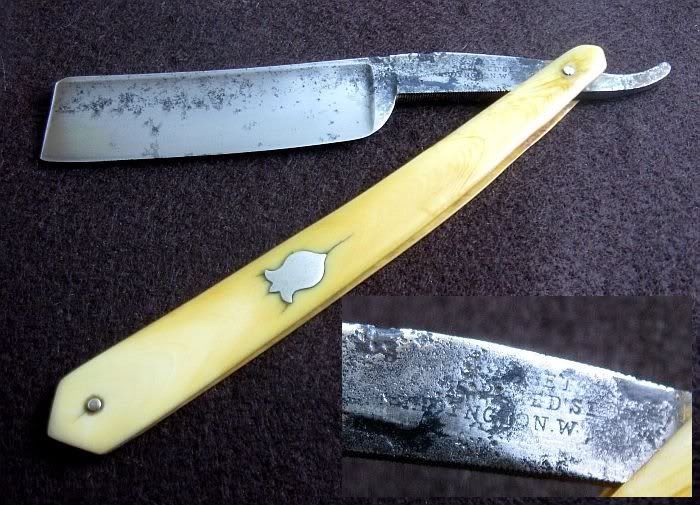Results 1 to 10 of 10
Thread: Could this be a Welsh razor?
Hybrid View
-
01-14-2010, 01:52 AM #1
 Could this be a Welsh razor?
Could this be a Welsh razor?
I recently purchased a razor that has some heavy pitting on that tang that obscures part of the maker's name and address. With a 20x loupe all I can make out is:
- - - - - - ET
- - - - - - ED ST
- - -DINGTON. W.
Could the W in the address stand for Wales? I am hoping that someone might be familiar with the maker. The razor has a 13/16 blade with a French point. The bone scales are pointed at both ends and it has a silver shield inlaid into the bone. Any help would be appreciated.
Regards- Walt

Last edited by Walt; 01-14-2010 at 10:30 PM.
-
01-14-2010, 03:30 AM #2

pictures might help
-
01-14-2010, 03:37 AM #3

If it predates the inclusion of country of manufacture, it might be short for something like "Paddington West". (Just a shot in the dark - don't know if that particular place exists.)
-
01-14-2010, 03:36 AM #4

Pictures would help, and your razor description is intriguing! It was likely made in Sheffield and branded with the vendor's name.
-
The Following User Says Thank You to Croaker For This Useful Post:
Walt (01-14-2010)
-
01-14-2010, 10:39 PM #5
-
01-14-2010, 10:55 PM #6

Shame about that split. Those scales are a kind of ivory, of which animal I am unsure. There is a distinct grain, rather than pits of old pores which bones have.
Perhaps that once said 'BEDDINGTON. W.' The W for West?
-
The Following User Says Thank You to Scipio For This Useful Post:
Walt (01-14-2010)
-
01-14-2010, 11:21 PM #7

I hadn't considered that the scales might be ivory. I guess I just assumed they were bone. But, you are correct, there is none of the usual "pitting" associated with bone. Both scales have a definite graining, almost like the rings of a tree. Hmmm. The split doesn't really bother me. It's a sign of age and wear and it gives it that "weathered" look. As long as it hones properly and gives a good shave, I'll be happy.
Regards - Walt
-
01-14-2010, 11:33 PM #8

The 'W' almost certainly stands for the old London district code that was used prior to postcoding in the UK. It started as the points of the compass - N,E,S and W, then later divided into subsections like NE, SW etc , then later again into such as NE3, SW4 etc until we now have the full postcoding. I'd guess the age about 1860.
-
The Following User Says Thank You to blueprinciple For This Useful Post:
Walt (01-14-2010)


 LinkBack URL
LinkBack URL About LinkBacks
About LinkBacks






 Reply With Quote
Reply With Quote

